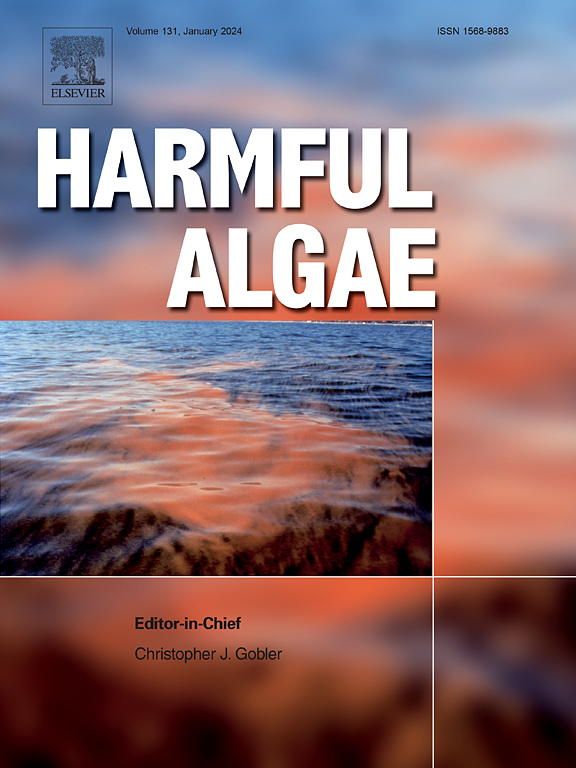大型富营养化湖泊中与浮游植物群落和蓝藻毒素产生有关的营养限制和季节性
IF 5.5
1区 生物学
Q1 MARINE & FRESHWATER BIOLOGY
引用次数: 0
摘要
尽管淡水有害藻华已经被描述和研究了几十年,但一些重要的动态仍然不确定,包括营养浓度、浮游植物生长和蓝藻毒素产生之间的关系。为了确定营养物质何时何地限制浮游植物、蓝藻细菌和蓝藻毒素,我们进行了原位生物测定研究。我们在不同季节从美国西部最大的淡水湖之一犹他湖的三个地点收集的水中添加了氮(N),磷(P)或N + P。这个浅的,富营养化的湖泊为量化营养-生长-毒素相互作用提供了一个强大的试验台。随着时间的推移,我们评估了一系列参数,包括光色素浓度、浮游植物丰度(细胞计数)、蓝藻毒素和营养物质浓度。尽管水体中本底营养物浓度较高,但浮游植物的丰度和组成受营养物添加的影响较大。磷限制在春季更为常见,氮限制和N + P限制在秋季更为常见。营养物添加与蓝藻(Microcystis, Aphanocapsa, Dolichospermum, Merismopedia, Aphanizomenon spp.),真核生物(Aulacoseira, Desmodesmus spp.)和浮游植物(单细胞和群体绿藻)两个分类类别呈正相关。当检测到anatoxin-a时,anatoxin-a与aphanizomena呈正相关,与Microcystis spp呈负相关。然而,总的蓝藻毒素浓度与蓝藻细胞密度无关,但随季节而变化。这些发现强调了考虑季节性养分可用性动态的重要性,并提供了对在世界各地类似富营养化湖泊环境的健康和管理中发挥重要作用的特定营养靶点、物种和蓝藻毒素的见解。本文章由计算机程序翻译,如有差异,请以英文原文为准。
Nutrient limitation and seasonality associated with phytoplankton communities and cyanotoxin production in a large, hypereutrophic lake
Though freshwater harmful algal blooms have been described and studied for decades, several important dynamics remain uncertain, including the relationships among nutrient concentrations, phytoplankton growth, and cyanotoxin production. To identify when and where nutrients limit phytoplankton, cyanobacteria, and cyanotoxins, we conducted in situ bioassay studies. We added nitrogen (N), phosphorus (P), or N + P across various seasons in water collected from three locations across Utah Lake, one of the largest freshwater lakes in the western U.S. This shallow, hypereutrophic lake provides a powerful testbed for quantifying nutrient-growth-toxin interactions. We assessed a range of parameters over time, including photopigment concentrations, phytoplankton abundance (cell counts), cyanotoxins, and nutrient concentrations. Despite high background nutrient concentrations in lake water, phytoplankton abundance and composition were strongly affected by nutrient addition. Phosphorus limitation was more common in the spring, with N limitation and N + P limitation becoming more common in the fall. Nutrient additions were positively associated with cyanobacteria (Microcystis, Aphanocapsa, Dolichospermum, Merismopedia, Aphanizomenon spp.), eukaryotes (Aulacoseira, Desmodesmus spp.), and two taxonomical categories of phytoplankton (i.e., unicellular and colonial green algae). When detected, anatoxin-a was positively associated with Aphanizomenon and negatively associated with Microcystis spp. However, overall cyanotoxin concentrations were not associated with cyanobacterial cell density but varied seasonally. These findings highlight the importance of considering seasonal nutrient availability dynamics and provide insights into specific nutrient targets, species, and cyanotoxins that play a significant role in the health and management of similar eutrophic lake environments around the world.
求助全文
通过发布文献求助,成功后即可免费获取论文全文。
去求助
来源期刊

Harmful Algae
生物-海洋与淡水生物学
CiteScore
12.50
自引率
15.20%
发文量
122
审稿时长
7.5 months
期刊介绍:
This journal provides a forum to promote knowledge of harmful microalgae and macroalgae, including cyanobacteria, as well as monitoring, management and control of these organisms.
 求助内容:
求助内容: 应助结果提醒方式:
应助结果提醒方式:


